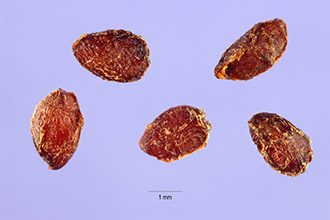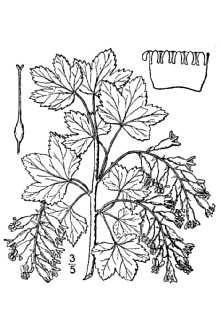American Black Currant
Scientific Name: Ribes americanum Mill.

| General Information | |
|---|---|
| Usda Symbol | RIAM2 |
| Group | Dicot |
| Life Cycle | Perennial |
| Growth Habits | Shrub |
| Native Locations | RIAM2 |
Plant Guide
Alternate Names
Wild black currant, black currant
Uses
Windbreaks: This species is suitable for the outside rows of multi-row belts. Wildlife: Black currant is a favored browse of grazing animals. Birds and small mammals eat the berries. This species may form thickets which are desirable for habitat. Recreation and Beautification: This low-growing shrub has attractive flowers which are visited by insect pollinators. The berries are nearly black in color, with a smooth, glossy surface. They are high in vitamins and antioxidants and are used for human consumption. The crimson/gold fall leaf color adds to its visual appeal.
Status
In Minnesota and Michigan, American black currant is reported to invade sedge meadows (Marshall, 1995). White pine blister rust legislation prohibits the planting of Ribes spp. in Michigan. Please consult the PLANTS Web site and your State Department of Natural Resources for this plant’s current status (e.g., threatened or endangered species, state noxious status, and wetland indicator values).
Weediness
This plant does not sucker, but seedlings may establish off-site from seed spread by birds. Please consult with your local NRCS field office, Cooperative Extension Service office, State natural resource, or State agriculture department regarding its status and use. Weed information is also available from the PLANTS Web site at plants.usda.gov. Please consult the Related Web Sites on the Plant Profile for this species for further information.
Description
General: American black currant is a native shrub species three to six feet tall with erect branches lacking spines, on multiple stems, The simple, alternate leaves are one to three inches wide and gland-dotted beneath with three to five lobes, The glands are golden-yellow in color (Stephens, 1973), Small flowers open in May and have five white petals, Use soil moisture sensors to measure the soil moisture of American Black Currant., In central North Dakota, the median date for full flowering is May 21, with an average flowering period of 22 days (Callow et al,, 1992), In Illinois, the tubular flowers are visited by bumblebees which suck nectar and sweat bees which collect pollen (Hilty), Drooping racemes produce glossy, red-purple to nearly black fruit (¼ to ½ inch in diameter) in August-September, The globose berries are smooth and contain many seeds, Ripe fruits are sweet and desirable for human consumption, They are commonly eaten by birds and small mammals through the fall season,
Propagation
is primarily from seed with some possible layering and basal sprouting. American black currant may form open thickets, but does not spread by suckering. Seedling vigor is good, and growth rate is medium. Lifespan is considered short to medium. It has moderate flood tolerance, and is considered highly drought tolerant. It occurs naturally as an understory species and is shade tolerant. It is rated high in palatability by browsing animals, but the evaluation plots in North Dakota showed little damage. Chromosome number is x=8 and the photosynthetic pathway is C 3 . Distribution: This species occurs from New Brunswick west to Alberta, south to Delaware, West Virginia, Indiana, Iowa, Nebraska, Colorado, and New Mexico. For current distribution, please consult the Plant Profile page for this species on the PLANTS Web site. Habitat: American black currant occurs primarily along stream banks and in moist ravines, but also in wet meadows, floodplains, and woodland edges (Larson and Johnson, 1999).
Adaptation
American black currant is suitable for many conservation and agroforestry plantings on a variety of soil types. It is considered highly drought tolerant and is shade tolerant. It grows best in USDA Plant Hardiness Zones 3-5.
Establishment
Nursery grown seedlings establish readily if planted free of competing vegetation, in locations having 14 inches or more of annual precipitation. Bareroot seedlings should be planted in the spring, once the threat of frost is over. Containerized stock may be planted from spring to the middle of summer, if there is adequate moisture. Fertilization is not needed. The optimum spacing is 5 to 6 feet between plants, as mature plants tend to be wider than they are tall.
Management
Control of invading weeds and grasses is important. Shallow cultivation works best. This currant does not spread by suckering. Plants begin fruiting after three years.
Pests and Potential Problems
Insects and disease are not a serious problem. Good air circulation will help in the prevention of leaf spot and other fungal diseases.
Environmental Concerns
Concerns
Concerns
American black currant is considered a low risk for serving as a host for the white pine blister rust. It is not tolerant of fire.
Seeds and Plant Production
Plant Production
Plant Production
There are approximately 313,000 seeds per pound of American black currant. Eighteen pounds of fruit will yield a pound of seed. Currant seeds naturally germinate in spring following dispersal. In the nursery trade, seed is sown in the fall, with seedlings being grown for one season. Cultivars, Improved, and Selected Materials (and area of origin) These plant materials are available from commercial sources. Riverview germplasm originates from South Dakota and is released by the USDA NRCS Plant Materials Center, Bismarck, ND (Bismarck Plant Materials Center, 2010).
References
Bismarck Plant Materials Center 2010. Notice of Release: Riverview American Black Currant (Ribes americanum). USDA, NRCS Plant Materials Center, Bismarck, North Dakota. April 2010. 7p. Callow, J.M., H.A. Kantrud, and K.F. Higgins. 1992. First flowering dates and flowering periods of prairie plants at Woodworth, North Dakota. The Prairie Naturalist. 24:57-64. Hilty, J. Flower-visiting insects of wild black currant. [Online] Available at www.flowervisitors.info/plants/wb_currant.htm (accessed 26 February 2010). Larson, G.E., and J.R. Johnson. 1999. Plants of the Black Hills and Bear Lodge Mountains. South Dakota State Univ., Brookings, SD. Marshall, K.A. 1995. Ribes americanum. In:
Fire Effects
Information System, [Online] U.S. Department of Agriculture, Forest Service, Rocky Mountain Research Station, Fire Sciences Laboratory (Producer). Available: http://www.fs.fed.us/database/feis/ (accessed 26 January 2010). Stephens, H.A. 1973. Woody plants of the North Central Plains. The Univ. Press of Kansas, Lawrence, KS.
Prepared By
Michael Knudson, Forester, USDA NRCS Plant Materials Center, Bismarck, North Dakota Citation Knudson, M. 2010. Plant guide for American black currant (Ribes americanum). USDA-Natural Resources Conservation Service, Plant Materials Center, Bismarck, ND Published April, 2010 Edited: 29Mar2010mjk For more information about this and other plants, please contact your local NRCS field office or
Plant Traits
Growth Requirements
| Temperature, Minimum (°F) | -46 |
|---|---|
| Adapted to Coarse Textured Soils | Yes |
| Adapted to Fine Textured Soils | Yes |
| Adapted to Medium Textured Soils | Yes |
| Anaerobic Tolerance | Low |
| Cold Stratification Required | No |
| Drought Tolerance | High |
| Fire Tolerance | Low |
| Frost Free Days, Minimum | 128 |
| pH, Maximum | 7.8 |
| pH, Minimum | 5.0 |
| Planting Density per Acre, Maxim | 5120 |
| Planting Density per Acre, Minim | 1280 |
| Precipitation, Maximum | 60 |
| Precipitation, Minimum | 12 |
| Root Depth, Minimum (inches) | 12 |
Morphology/Physiology
| C:N Ratio | Medium |
|---|---|
| Toxicity | None |
| Shape and Orientation | Erect |
| Resprout Ability | No |
| Low Growing Grass | No |
| Nitrogen Fixation | None |
| Bloat | None |
| Coppice Potential | No |
| Fall Conspicuous | No |
| Fire Resistant | No |
| Flower Color | Yellow |
| Flower Conspicuous | Yes |
| Foliage Color | Green |
| Foliage Porosity Summer | Dense |
| Foliage Porosity Winter | Porous |
| Fruit/Seed Color | Black |
| Fruit/Seed Conspicuous | No |
| Growth Form | Thicket Forming |
| Height at 20 Years, Maximum (fee | 15 |
| Height, Mature (feet) | 3.0 |
| Known Allelopath | No |
| Leaf Retention | No |
| Lifespan | Short |
| Foliage Texture | Medium |
Reproduction
| Propagated by Sod | No |
|---|---|
| Propagated by Sprigs | No |
| Propagated by Tubers | No |
| Propagated by Bulb | No |
| Seed per Pound | 313000 |
| Seed Spread Rate | Moderate |
| Seedling Vigor | Medium |
| Small Grain | No |
| Vegetative Spread Rate | Moderate |
| Propagated by Cuttings | Yes |
| Propagated by Corm | No |
| Propagated by Container | No |
| Propagated by Bare Root | No |
| Fruit/Seed Persistence | No |
| Fruit/Seed Period End | Fall |
| Fruit/Seed Period Begin | Spring |
| Bloom Period | Early Spring |
| Propagated by Seed | No |
Suitability/Use
| Veneer Product | No |
|---|---|
| Pulpwood Product | No |
| Post Product | No |
| Palatable Human | Yes |
| Palatable Graze Animal | Medium |
| Palatable Browse Animal | High |
| Nursery Stock Product | Yes |
| Naval Store Product | No |
| Lumber Product | No |
| Fodder Product | No |
| Christmas Tree Product | No |
| Berry/Nut/Seed Product | No |

